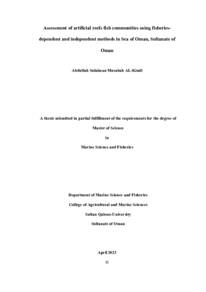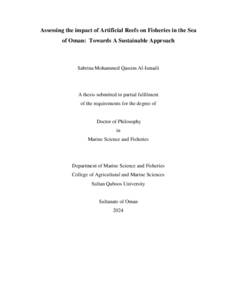Document
Assessment of artificial reefs fish communities using fisheries dependent and independent methods in Sea of Oman, Sultanate of Oman.
Publisher
Sultan Qaboos University.
Gregorian
2023
Language
English
Subject
English abstract
Marine artificial reefs (ARs) are structures that are submerged in the ocean to restore
and provide habitats for marine organisms, increase fish populations and biodiversity.
The species richness and composition are critical criteria for ecosystem functioning
and stability, and there is an urgent need to preserve marine biodiversity by protecting
and restoring reef habitats. This study assessed whether ARs successfully enhance
fisheries productivity using both fisheries-dependent and independent survey
methods, and investigated the impacts of physio-chemical parameters on the fish
communities at Suhar, Sea of Oman, Sultanate of Oman. The study sites were selected
based on age (old, middle and young) and depth (shallow, deep) categories. To
characterize fish communities at ARs, sites, fisheries-independent methods included
diver operated stereo-video (DOVs) and Baited Remote Underwater stereo‐video
(BRUVs), while the fisheries-dependent method involved deploying fish traps to
assess fish communities abundance and biomass. Environmental parameters
(temperature, salinity, dissolved oxygen) were collected. The shallow (11 - 13 m) and
old (~ 20 years old) ARs sites had higher catch per unit effort (CPUE) than the nearby
deep natural reefs (20 - 22 m) and middle-aged (~15 years old) sites, indicating that
ARs enhance fisheries productivity in this area. The highest number of individuals
were found on shallow and deep ARs in both summer and winter surveys. The non metric multi-dimensional scaling (NMDS) analyses showed that the fish assemblages
of ARs sites were different from nearby natural reef sites. Lutjanus lutjanus )> 19cm)
was one of the most common important fisheries species, which was abundant on
deeper ARs. The Lutjanidae family were the most abundant family recorded in fish
traps and the DOVs surveys. However, Carangidae was the most abundant family
observed in BRUVs surveys, as they are highly mobile, and bait attracted. These
results highlight the importance of using different methods to monitor ARs. Depth
was a key factor in the difference in physico-chemical parameters between both
seasons. Depth was highly correlated with species evenness and dissolved oxygen in
winter. This study illustrates that ARs enhance fisheries productivity in the Suhar
region. However, the mature ARs will enhance the fish productivity in compare to
young ARs.
Member of
Resource URL
Arabic abstract
الشعاب البحرية الاصطناعية )ARs )هي هياكل مغمورة في المحيط الستعادة وتوفير موائل للكائنات البحرية ، وزيادة وفرة الاسماك والتنوع الاحيائي. ويعد ثراء الانواع وتكوينها من المعايير الحاسمة لعمل النظام البيئي واستقراره، وهناك حاجة ملحة للحفاظ على التنوع الاحيائي من خلال حماية واستعادة موائل الشعاب المرجانية. قيمت هذه الدراسة ما إذا كانت الشعاب الصناعية قد نجحت في تعزيز مصايد الاسماك باستخدام كل من طرق المسح المعتمدة على مصائد الاسماك وتلك التي لا تعتمد على مصائد الاسماك خلال فصلي الصيف والشتاء، وبحثت آثار المعايير الفيزيائية والكيميائية على مجتمعات الاسماك في والية صحار في بحر عمان، سلطنة عمان. لتوصيف مجتمعات الاسماك في مواقع الشعاب المرجانية الصناعية، تضمنت ُطعم، في حين طرق المسح المستقلة عن مصائد الاسماك عن طريق نظام فيديو يحمله الغواص ونظام فيديو عن بعد مزود ب أن طرق المسح الغير مستقلة تضمنت مصائد الاسماك باستخدام الاقفاص المعروفة محليا بالدوابي او الجراجير. وتم جمع بيانات المؤشرات البيئية للبحر )درجة الحرارة، الملوحة، الاكسجين المذاب( باستخدام أجهزة الCTD ومسجالت الحرارة. كان لدى مواقع الشعاب الصناعية الضحلة )11 إلى 13 مت ًرا( والقديمة )حوالي 20 عا ًما( أعلى صيدا لكل وحدة جهد من مواقع الشعاب الطبيعية العميقة )-20 22 مترا( والمواقع المتوسطة العمر )حوالي 15 عا ًما(، مما يشير إلى أن الشعاب الصناعية يمكن أن تعزز إنتاجية المصائد الضحلة والعميقة. تم العثور على أكبر عدد من الاسماك في الشعاب الصناعية الضحلة والعميقة في كل من المسوح الصيفية والشتوية كما أظهرت تحليلات القياس متعددة الابعاد الغير قياسية أن التجمعات السمكية لمواقع الشعاب الصناعية كانت مختلفة عن مواقع الشعاب الطبيعية. وكان نوع lutjanus Lutjanus أحد أهم أنواع المصائد، والذي شوهدت الاسماك البالغة منه )حجم 24-13 سم( بشكل شائع في الشعاب الصناعية العميقة. وكانت عائلة ال LUTJANIDAE هي الاكثر وفرة المسجلة في مصائد الاسماك في مسوحات الفيديو التي يديرها الغواص وكانت عائلة الطعم لأن أنواع هذه العائلة كثيرة الحركة وتنجذب الى رائحة CARANGIDAE الاكثر وفرة في نظام الفيديو عن بعد المزود بطعم مما يدل على أهمية استخدام طرق مختلفة لمراقبة في اختلاف المعايير ُطعم الشعاب الصناعية. ولقد كان العمق عامالً رئيسياً الفيزيائية والكيميائية بين الموسمين. حيث أشار تحليل الترابط الخطي الى وجود علاقة ايجابية ذات دلالة إحصائية بين كل من العمق وتكافؤ الانواع، وبين العمق والاكسجين المذاب في فصل الشتاء. تؤكد هذه الدراسة ان الشعاب الصناعية يمكن أن تعزز إنتاجية مصايد الاسماك، ولذلك فإنها تتطلب مزيدًا من الوقت لتحقيق الهدف المرجو منها.
Category
Theses and Dissertations


